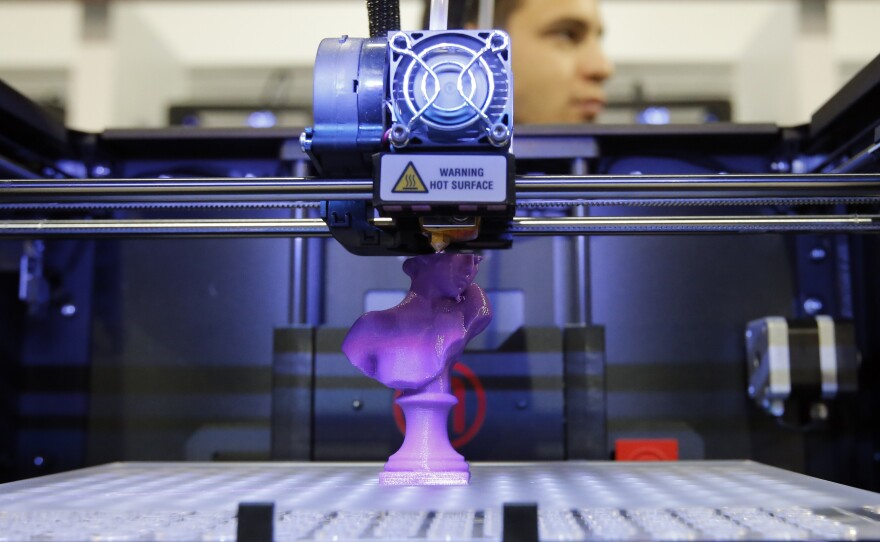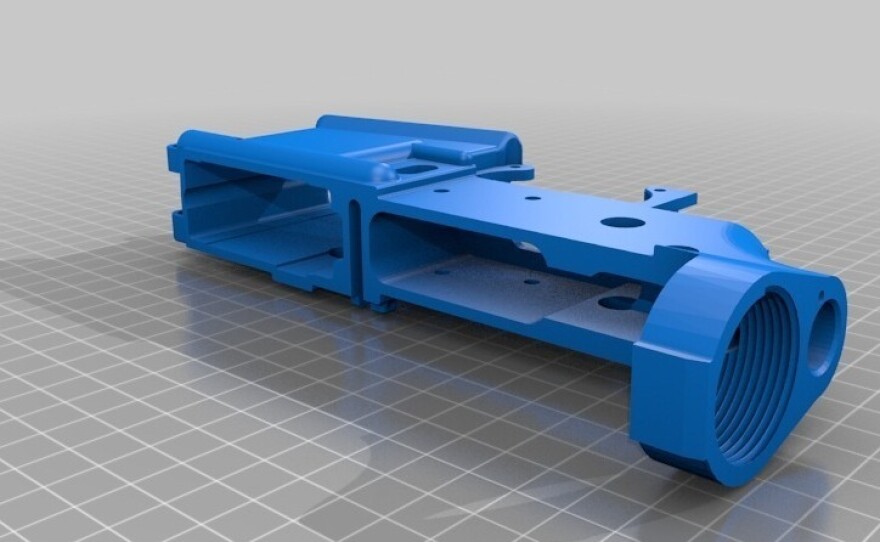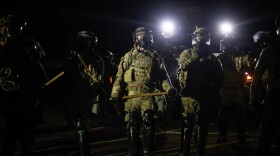
You may have heard about 3-D printing, a technological phenomenon that uses a robotic arm to build objects one layer at a time. As people get imaginative and create items in a one-stop-shop fashion, one more creation has been added to the printing line: gun parts.
On the West Side of Manhattan, behind large glass windows, a dozen 3-D printers build plastic toys and jewelry. Hilary Brosnihan, a manager at 3DEA, an events company that sponsored a print pop-up store, says things are moving rapidly.
"This [3-D printing] is coming down the line; it's coming down the line very quickly," Brosnihan says.
She also works as a toy manufacturer. The technology has boosted her business, but the idea of printing a gun horrifies her. She says most of her colleagues feel the same way.
"They are more of an open-source community that's about developing things that are useful. And in our terms, weapons aren't really useful," Brosnihan says. "Creating a way to adjust your sink faucet so you don't have issues with it -- that's useful."
But a lot of Americans do think guns are useful.
Matt Griffin, who works in the tech industry, is writing a book about 3-D printing. When he visits colleagues outside New York or San Francisco, he says there's a definite cultural difference on guns.
He cites the Midwest as an example, where "amazing makers" idealize creating cars and guns, and don't see it as being separate from other design items seen on the Web.
It would be easy to conceive the idea that 3-D printers are churning out cheap handguns, but there's a kink in the process. If you were to print an entire gun out of plastic, it wouldn't work. The bullet should shatter the plastic.
You can print a gun in metal, but that kind of technology is not available to hobbyists now, and won't be anytime in the near future.
"The primary ways of doing this involve vacating a chamber and flooding it with gases," Griffin explains. "And you have to keep the gases mixed at this really careful percentage or it explodes. It doesn't fizzle out and stop working -- it actually explodes."
But you can print a vital gun piece called the lower receiver -- the central component that connects many of the other parts.
"The government considers the lower receiver the gun; that's the part with the serial number, that's the part that's regulated," says Pete Prodoehl, a 3-D print shop worker from Milwaukee.
That's how officials trace guns. But if someone wanted to build an unregulated gun at home, they could already do it with cheap, off-the-shelf parts. And people usually don't -- for a good reason.
"It might fire once and it might not blow up in your face," Prodoehl says. "But, you know, building something that is reliable and repeatable and somewhat safe for the user is a little more tricky."
The design for printing the lower receiver was on Thingiverse.com, but its parent company, MakerBot, took it down after the mass shooting in Newtown, Conn., claiming it violated its terms of use. (MakerBot declined an interview request.) Other 3-D printing companies declined to post the design on their websites, but it's still easy to find online.
Advocates of 3-D printing worry the technology is getting caught up in the national debate over guns. For many of Griffin's colleagues, the issue comes down to personal responsibility -- which, in a way, mirrors the gun debate itself.
"I met some folks who were saying, 'I don't want anybody to tell me I can't make something,' " Griffin says. "So hearing somebody talk about, you know, maybe we need to talk about what people should be allowed to or able to make, they would get extremely upset."
At least one congressman is concerned about where 3-D printing is headed: Rep. Steve Israel, D-N.Y., is pushing to renew a 1988 law that bans plastic weapons.
Copyright 2013 NPR. To see more, visit www.npr.org.






